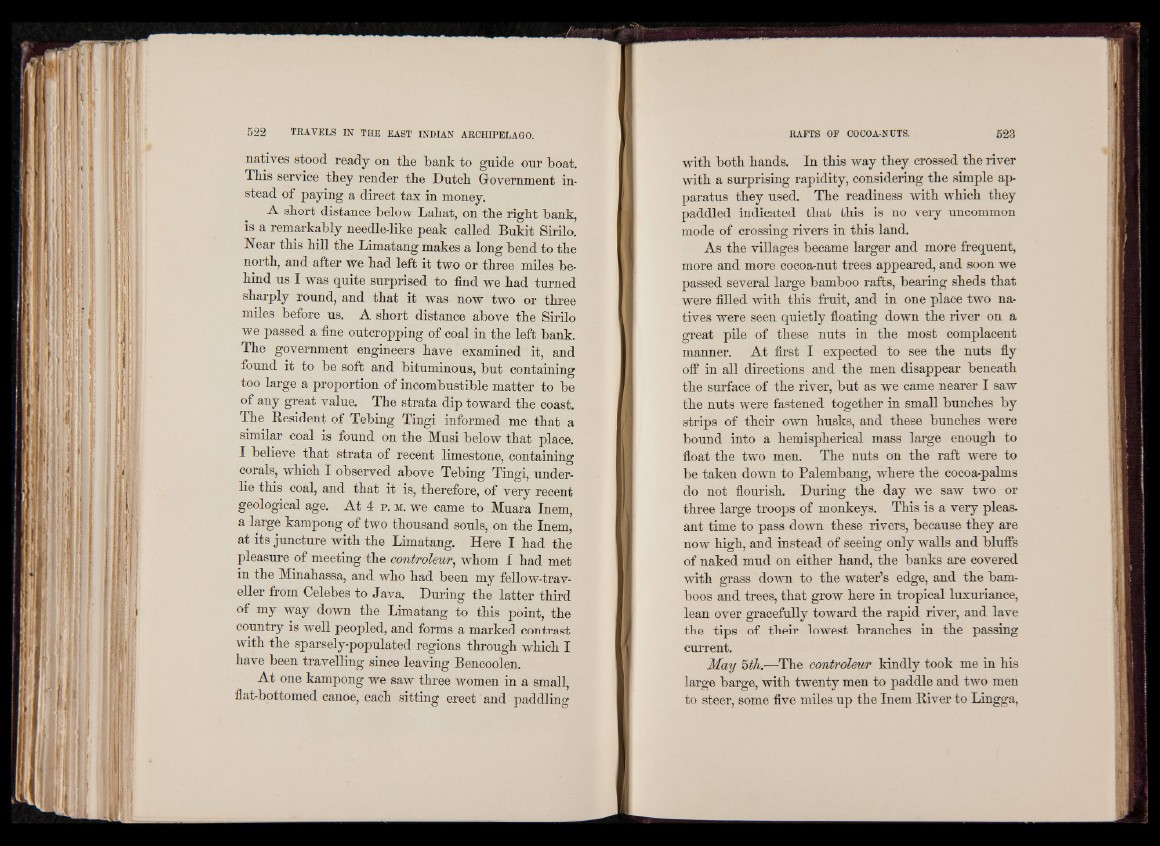
natives stood ready on the b an t to guide our boat.
This service they render the Dutch Government instead
of paying a direct tax in money.
A short distance below Lahat, on the right bank,
is a remarkably needle-like peak called Bukit Sirilo.
Near this hill the Limatang makes a long bend to the
north, and after we had left it two or three miles behind
us I was quite surprised to find we had turned
sharply round, and that it was now two or three
miles before us. A short distance above the Sirilo
we passed a fine outcropping of coal in the left bank.
The government engineers have examined it, and
found it to be soft and bituminous, but containing
too large a proportion of incombustible matter to be
of any great value. The strata dip toward the coast.
The Resident of Tebing Tingi informed me that a
similar coal is found on the Musi below that place.
I believe that strata of recent limestone, containing
corals, which I observed above Tebing Tingi, underlie
this coal, and that it is, therefore, of very recent
geological age. At 4 p. m. we came to Muara Inem,
a large kampong of two thousand souls, on the Inem,
at its juncture with the Limatang. Here I had the
pleasure of meeting the controlewr, whom I had met
in the Minahassa, and who had been my fellow-traveller
from Celebes to Java. During the latter third
of my way down the Limatang to this point, the
country is well peopled, and forms a marked contrast
with the sparsely-populated regions through which I
have been travelling since leaving Bencoolen.
At one kampong we saw three women in a small
flat-bottomed canoe, each sitting erect and paddling
with both hands. In this way they crossed the river
with a surprising rapidity, considering the simple apparatus
they used. The readiness with which they
paddled indicated that this is no very uncommon
mode of crossing rivers in this land.
As the villages became larger and more frequent,
more and more cocoa-nut trees appeared, and soon we
passed several large bamboo rafts, bearing sheds that
were filled with this fruit, and in one place two natives
were seen quietly floating down the river on a
great pile of these nuts in the most complacent
manner. At first I expected to see the nuts fly
off in all directions and the men disappear beneath
the surface of the river, but as we came nearer I saw
the nuts were fastened together in small bunches by
strips of their own husks, and these bunches were
bound into a hemispherical mass large enough to
float the two men. The nuts on the raft were to
be taken down to Palembang, where the cocoapalms
do not flourish. During the day we saw two or
three large troops of monkeys. This is a very pleasant
time to pass down these rivers, because they are
now high, and instead of seeing only walls and bluffs
of naked mud on either hand, the banks are covered
with grass down to the water’s edge, and the bamboos
and trees, that grow here in tropical luxuriance,
lean over gracefully toward the rapid river, and lave
the tips of their lowest branches in the passing
current.
May 5th.—The controlewr kindly took me in his
large barge, with twenty men to paddle and two men
to steer, some five miles up the Inem River to Lingga,